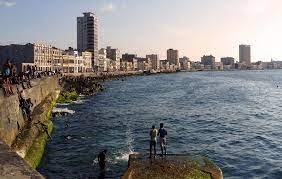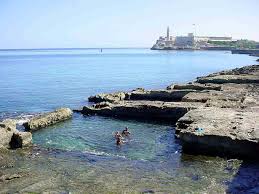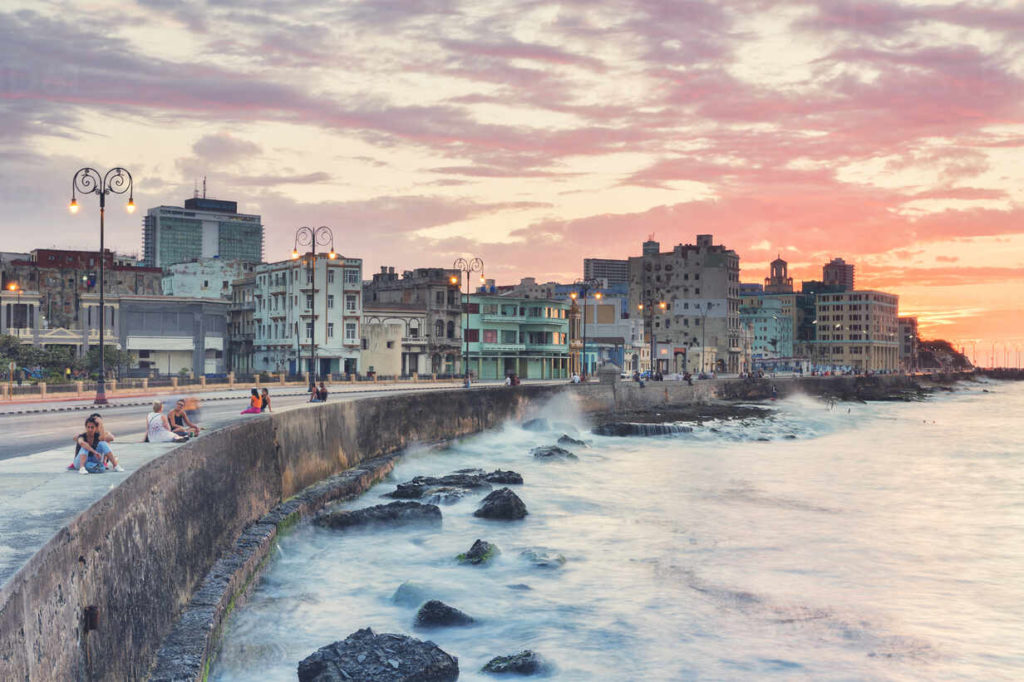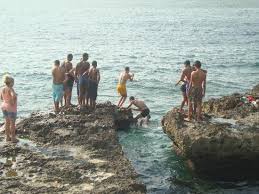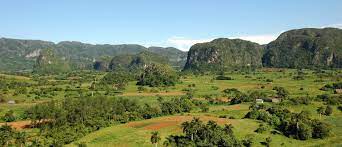EL MALECÓN DE LA HABANA, CUBA Y SUS FAMOSOS CASI OLVIDADOS BAÑOS. PHOTOS.
El Malecón es un atractivo paseo marítimo de aproximadamente ocho kilómetros de longitud ubicado en La Habana, Cuba. Este enorme paseo marítimo es también una de las avenidas más auténticas y famosas de toda Cuba. El Malecón de La Habana fue concebido originalmente por autoridades de los EE.UU. a principios del siglo XX. La construcción de la pasarela se inició a principios de 1900 no mucho después de la Guerra Española-Estadounidense.
LA HISTORIA DEL MALECÓN o “Avenida de Antonio Maceo”, nombre casi desconocido para muchos cubanos, comenzó en 1819 cuando se puso en práctica el llamado “ensanche de extramuros”, pues la ciudad estaba creciendo y el espacio costero que iba desde la entrada de la bahía hasta el Torreón de San Lázaro, era solo un espacio abierto de roca y mar, hermoso pero sin otra señal que lo inhóspito del lugar, a donde iban algunas familias a tomar baños de mar en esos “barracones de madera pomposamente llamados baños…” a los que Tella hace referencia.
Desde la zona del litoral habanero donde hoy está el Parque Maceo y hasta el Río Almendares, lo que existía entonces era una costa de agudos arrecifes y un monte firme e impenetrable, que las autoridades españolas consideraban como una muralla natural ante los ataques y lo llamaban “Monte Vedado”. De aquí el nombre de lo que sería posteriormente lo que conocemos como el municipio Vedado.
Desde finales del siglo XIX, esta franja de territorio habanero vio vestir con recatados trajes de baño a nuestros abuelos en los días calurosos de nuestro verano, cuando aprovechando los viejos senderos de pescadores descendían por la parte posterior de sus casas para bajar a las pocetas y refrescarse en el mar. Todavía hoy se pueden ver algunas labradas en las rocas y que en aquella época se cubrían de toldos y de sombrillas en la época del verano.
Hasta 1895 hubo un desarrollo notable en el caserío de El Vedado. La cercanía del mar hizo que el barrio cobrara relevancia. En la línea de la costa, desde G hasta 6, se establecieron, a partir de 1864, varios balnearios y constituyeron una opción más asequible para las familias de menos recursos, sobretodo en su modalidad de baños públicos. La gente se bañaba entonces en lo que se llamaban pocetas de ahogado, que se aprovechaban de la disposición de las rocas o se cavaban artificialmente en estas. Las había pequeñas, con locales reservados para la familia, y otras muy amplias, en las que se bañaban, por separado, hombres y mujeres.
Entonces la calle E fue conocida popularmente con el nombre de “Baños”, porque llevaba a las pocetas del balneario “El Progreso”, el primero que se construye, en 1864. A fines de siglo se construyeron además, los baños de mar “Las Playas” frente a la calle D y posteriormente “El Encanto”, “El Carneado”, en Paseo, y otros como “El Encanto” y “El Océano”. Eran a la mar abierta, pero tenían unas divisiones para que no pudiera pasar los temidos tiburones.
El dueño de “El Progreso” lo convirtió en un gran negocio. Sobre la gran nave que cubría sus pocetas construyó 14 apartamentos dotados de sala-comedor, dos habitaciones y servicios, que alquilaba por cien pesos mensuales, y en Tercera, entre B y C, edificó varias casas de madera, pequeñas, destinadas también al alquiler durante la temporada veraniega. Sin contar que por el derecho al baño de mar cobraba 50 centavos.
LOS BAÑOS DEL MALECÓN HABANERO
Los baños de Carneado, en Malecón y Paseo, llegaron a ser la mejor diversión habanera para el domingo. Eran propiedad del llamado “Hombre-Grito”, por la promoción que hacía de su peletería en la Manzana de Gómez. Carneado presumía de riqueza, fortaleza física y varonía. Su riqueza la hacía evidente con tres brillantes gigantescos que formaban parte invariable de su atuendo. Para exhibir su fuerza, colocó una estatua suya, completamente desnudo y con los músculos en tensión, en las afueras de su residencia, situada también en las cercanías del litoral, y de su cualidades como varón, exhibía con orgullo sus más de 20 hijos, de todos los colores, que daban fe de su calidad de Don Juan.
La gente se bañaba entonces en lo que se llamaban pocetas de ahogado, que se aprovechaban de la disposición de las rocas o se cavaban artificialmente en estas. Las había pequeñas, con locales reservados para la familia, y otras muy amplias, en las que se bañaban, por separado, hombres y mujeres.
Todos estos baños de mar, desaparecieron con la urbanización de la ciudad y la construcción del Malecón. En una de las fotos, de la publicación, se puede observar a la distancia que algunas construcciones quedaron de la costa.
El Malecón de la Habana es uno de los puntos de encuentro favoritos de amantes, poetas, cantantes folclóricos, filósofos y pescadores. El Malecón tiene un ambiente especialmente apasionante cuando oscurece, ya que aquí podrás vivir una de las mejores puestas de sol que ofrece la isla.
Por Suerte en el Malecón Habanero tenemos un lugar inigualable del cual nos sentimos orgullosos. ¿O no?
THE MALECÓN OF HAVANA, CUBA AND ITS FAMOUS ALMOST FORGOTTEN BATHROOMS. PHOTOS
The Malecón is an attractive boardwalk of approximately eight kilometers in length located in Havana, Cuba. This huge promenade is also one of the most authentic and famous avenues in all of Cuba. The Malecón de La Habana was originally conceived by US authorities at the beginning of the 20th century. Construction of the walkway began in the early 1900s not long after the Spanish-American War.
THE HISTORY OF THE MALECÓN or “Avenida de Antonio Maceo”, a name almost unknown to many Cubans, began in 1819 when the so-called “expansion of extramuros” was put into practice since the city was growing and the coastal area that ran from the entrance to The bay up to the Torreón de San Lázaro, was just an open space of rock and sea, beautiful but with no other sign than the inhospitable nature of the place, where some families went to take sea baths in those “wooden barracks pompously called baths … ”To which Tella refers.
From the area of the Havana coast where the Maceo Park is today and up to the Almendares River, what existed then was a coast of sharp reefs and a firm and impenetrable mountain, which the Spanish authorities considered as a natural wall against the attacks and called it “Monte Vedado”. Hence the name of what would later become what we know as the Vedado municipality.
Since the end of the 19th century, this strip of Havana has seen our grandparents dress in modest swimsuits on hot summer days, when, taking advantage of the old fishermen’s trails, they descended from the back of their houses to go down to the pools and cool off in the sea. Even today you can see some carved in the rocks and that at that time was covered with awnings and umbrellas in the summertime.
Until 1895 there was a remarkable development in the village of El Vedado. The proximity of the sea made the neighborhood become relevant. On the coastline, from G to 6, several spas were established from 1864 and they constituted a more affordable option for families with fewer resources, especially in their form of public baths. People then bathed in what were called drowning pools, which took advantage of the arrangement of the rocks or dug themselves artificially in them. There were small ones, with rooms reserved for the family, and others very spacious, in which men and women bathed separately.
Then the street E was popularly known by the name of “Baños”, because it led to the pools of the spa “El Progreso”, the first to be built, in 1864. At the end of the century, the sea baths “Las Beaches ”in front of Calle D and later“ El Encanto ”,“ El Carneado ”, in Paseo, and others such as“ El Encanto ”and“ El Océano ”. They were in the open sea, but they had divisions so that the dreaded sharks could not pass.
The owner of “El Progreso” turned it into a great business. On the large nave that covered its wells, he built 14 apartments equipped with a living-dining room, two rooms, and services, which he rented for one hundred pesos a month, and in Third, between B and C, he built several small wooden houses, also intended for rent. during the summer season. Not counting that for the right to swim in the sea he charged 50 cents.
THE BATHROOMS OF THE MALECÓN HABANERO
The Carneado baths, on Malecón and Paseo, became the best fun in Havana for Sunday. They were owned by the so-called “Man-Scream”, for the promotion he made of his fur shop in the Manzana de Gómez. Carneado boasted wealth, physical strength, and manhood. His wealth made it evident with three gigantic diamonds that were an invariable part of his outfit. To show his strength, he placed a statue of himself, completely naked and with tense muscles, on the outskirts of his residence, also located near the coast, and of his qualities as a man, he proudly exhibited his more than 20 children, of all colors, which attested to his quality as Don Juan.
People then bathed in what were called drowning pools, which took advantage of the arrangement of the rocks or dug themselves artificially in them. There were small ones, with rooms reserved for the family, and others very spacious, in which men and women bathed separately.
All these sea baths disappeared with the urbanization of the city and the construction of the Malecón. In one of the photos, from the publication, you can see from the distance that some buildings were left from the coast.
The Malecón de la Habana is one of the favorite meeting points for lovers, poets, folk singers, philosophers, and fishermen. The Malecón has an especially exciting atmosphere when it gets dark since here you can experience one of the best sunsets the island has to offer.
Luckily, on the Malecón Habanero, we have a unique place of which we are proud. Or not?
Agencies/ Wiki/ MemoriasCubanas/ Derubin Jacomé/ Extractos/ Excerpts/ Internet Photos/ Arnoldo Varona/ www.TheCubanHistory.com
THE CUBAN HISTORY, HOLLYWOOD.



 EL MALECÓN DE LA HABANA, CUBA y sus Famosos casi Olvidados Baños. PHOTOS. * THE MALECÓN OF HAVANA, CUBA, and its Famous almost Forgotten Bathrooms. PHOTOS
EL MALECÓN DE LA HABANA, CUBA y sus Famosos casi Olvidados Baños. PHOTOS. * THE MALECÓN OF HAVANA, CUBA, and its Famous almost Forgotten Bathrooms. PHOTOS
